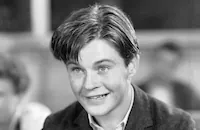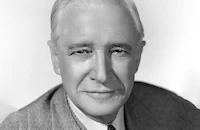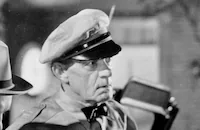Annapolis Farewell
Cast & Crew
Alexander Hall
Sir Guy Standing
Rosalind Keith
Tom Brown
Richard Cromwell
John Howard
Film Details
Technical Specs

Synopsis
At the Annapolis Naval Academy, retired Commodore Fitzhugh, who is disillusioned by the state of the modern navy, reminisces about his days as Commander of the U.S.S. Congress and in particular his participation in the Battle of Manila Bay under Admiral Dewey. Among the newly arrived plebes are Morton "Click" Haley, younger brother to senior class officer Duncan Haley, and Boyce Avery. Click's mind is more on football and girls than on the navy, and he gets into trouble when he tells Duncan that Boyce is sick in order to take Boyce's out-of-town girl friend, Madeleine Deming, to the June ball. Click meets Madeleine at the train station and escorts her to Fitzhugh's house. Because Click has expressed a specious interest in the commander's Congress stories, Fitzhugh agrees to let Madeleine stay at his home. When Duncan discovers Click's scheme, he orders him to find a four-leaf clover in the football field, causing Click to miss the ball. Click, however, refuses to tell Boyce where Madeleine is staying, and Madeleine finally tells Fitzhugh it is up to him to save the name of the navy by taking her to the dance. There, the commander pridefully leads a march around the dance floor to "Stars and Stripes Forever" and confesses to Madeleine he has experienced the happiest moment of his life. Later, at graduation ceremonies, rumors spread that Duncan will be quitting the navy for a professional football career, but Duncan remains loyal to the navy. While the Congress is docked in the harbor, Fitzhugh, looking fondly off to sea, calls it his ship. Click, bitter about his own father's fate in the navy, warns Duncan that the navy will parade Duncan around then use him for target practice as they have the Congress . Fitzhugh overhears this remark and Click cruelly tells him they are going to sink his ship. Fitzhugh appeals to naval authorities to save the ship, but is met with indifference. Grief-stricken, Fitzhugh relives the Battle at Manila Bay in his mind, then orders a sailor to row him out to the boat. While Fitzhugh sleeps inside the ship, it is towed off Cape Henry for target practice. He wakes, disoriented, believing he is back in the past, and when the sailors attack from shore, he believes the battle is raging. As water pours into the ship, the commander is hit over the head and, whispering that he is part of one of the great moments of history, sinks with the ship. On shore, Fitzhugh's faithful servant, Miranda, reports the commander missing and says she saw him being rowed to the ship. Click accuses himself of killing the commander because he was the gunner who affected a direct hit on the bridge. At Fitzhugh's funeral, he is eulogized for living by the words "don't give up the ship." Click, Boyce and Duncan cry in remembrance of a great navy man.

Director

Alexander Hall
Cast
Sir Guy Standing
Rosalind Keith

Tom Brown

Richard Cromwell

John Howard
Benny Baker

Louise Beavers

Minor Watson
Ben Alexander
John Darrow
William Collier Sr.
U.s. Naval Academy
Dorothy Vaughan
Oscar Rudolph
Frank Losee
Richard (tex) Brodus

Samuel S. Hinds

Wheeler Oakman
Harry Strang
Jack Keats
Hal Craig
Dick Wright
John Morley

Clyde Fillmore
Lyster Chambers
Fred Leslie
George Glass
Brady Kline
Kenneth Howell
Fred "snowflake" Toones
Marie Stevens
Harvey Clark
George Knowles
Lt. (j.g.) Edward A. Hutchinson
Ernest Van Pelt
Stanley Andrews
Edward Hinkley
William Arnold
David Newell
Guy Usher
Allen Pike
Bob Ward
Charles Sullivan
Larry Wheat
Joseph W. Girard
Burr Caruth

Lew Kelly
Thomas Curran
Jack Chapin

David Carlyle
Robert Hoover
William Newell
Jack Glenn
Crew
Comm. Oscar C. Badger
Arnold Belgard
Frank Craven
Hans Dreier
John Goodman
Oscar Hammerstein Ii
Doane Harrison
Henry Herzbrun
Lt. (j.g.) Edward A. Hutchinson
Grover Jones
Louis D. Lighton
William Slavens Mcnutt
Lieut. John F. Newman Jr.
Lt. Comm. Theodore T. Patterson
Gilbert Pratt
Sigmund Romberg
Ted Tetzlaff
Capt. Ford A. Todd
Dale Van Every
Bobby Vernon
Jack Wagner
Lt. Comm. Jerauld Wright
Adolph Zukor

Film Details
Technical Specs

Quotes
Trivia
Notes
This film is dedicated to "our Navy...its officers and men...in particular the officers and midshipmen of the U.S. Naval Academy." A working title for this film was Target. According to Daily Variety, the preview running time was 90 minutes, suggesting that considerable footage was edited out before general release. According to news items in Film Daily in early April 1935, at various times, Henry Hathaway and Lewis Milestone were set to direct this film, which was shot at the U.S. Naval Academy in Annapolis, MD. On May 7, 1935, Daily Variety reported that the day before, a TWA airplane carrying an advance crew who were to shoot exteriors at the Naval Academy, crashed in Macon, MO, killing four. Among those who died was U.S. Senator Bronson Cutting of New Mexico. Among those injured were director Richard Wallace and unit manager Paul Wing (actress Toby Wing's father). An entire new crew was recruited, and Alexander Hall took over as director, although the studio had wanted to recruit Alfred Santell, who was not available. According to a January 22, 1936 news item in Hollywood Reporter, Henry T. Sharp, who had been scheduled to photograph this film prior to the plane crash, sued TWA for $513,000 damages, charging negligence in the operation of the airplane. Daily Variety reported on May 17, 1935 that an epidemic of scarlet fever in Annapolis had forced the crew to take lodging in Baltimore and commute to Annapolis for filming. On June 25, 1935, Hollywood Reporter reported that actor John Cox changed his name to John Howard. This is the first film in which he was billed by his new name.












